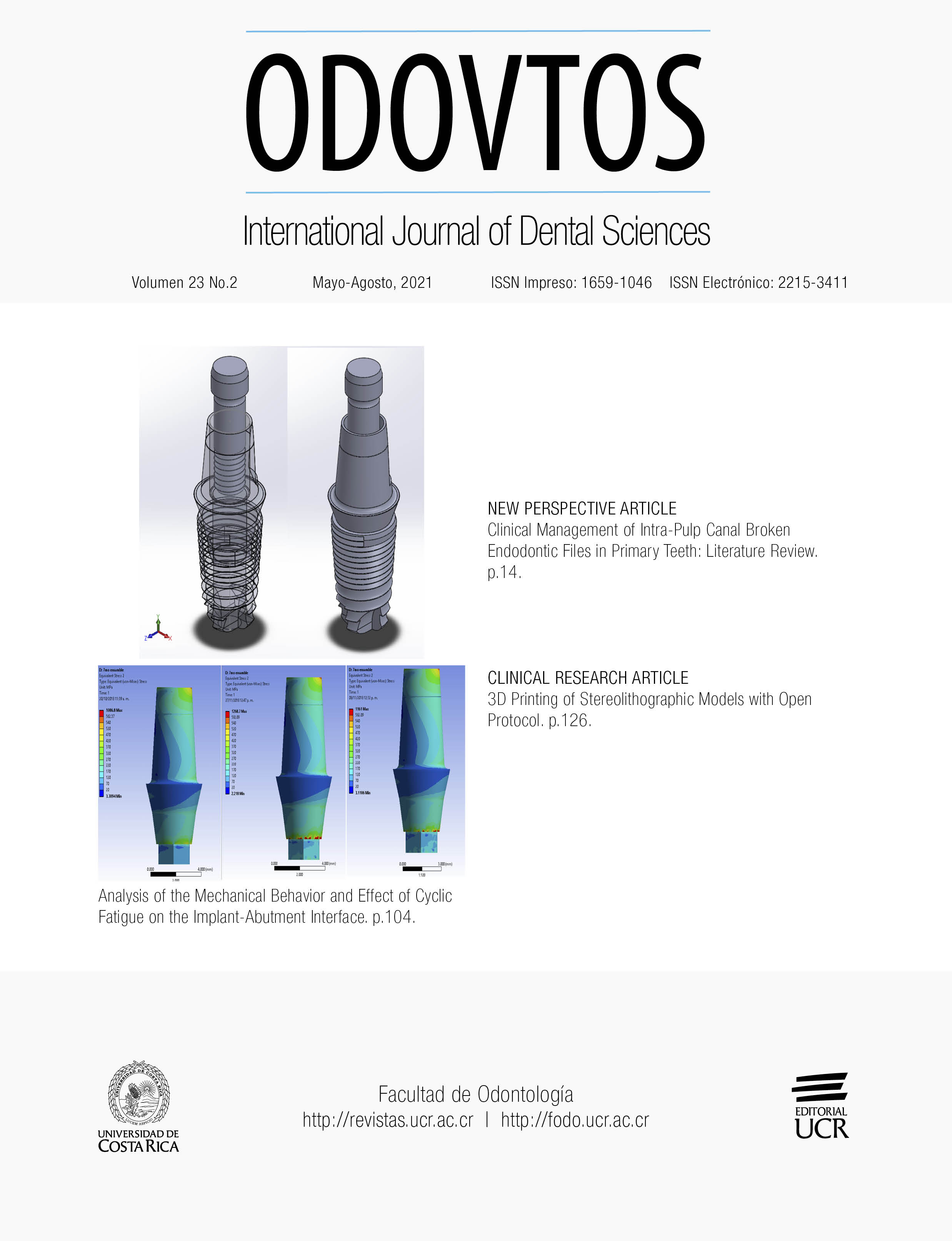Resumen
Propósito: El propósito de este estudio fue evaluar la decoloración de resinas bulk de curado dual (DCBF) y bulk activadas por fotopolimerización (LCBF) en relación con las resinas convencionales (CC) después de la inmersión en agua y café. Métodos: Se prepararon cien muestras en forma de disco (8mm de diámetro × 4mm de espesor) utilizando cinco resinas compuestas disponibles comercialmente (n=10); dos LCBF (XB-X-trafil Voco, FB-FiltekTM Bulk Fill), un DCBF (FU-Fill-upTM Coltene) y dos CC (CE-Clearfil Majesty ES2, EQ-Estelite ΣQuick). Las lecturas de color inicial y final se midieron con un espectrofotómetro (Easyshade, Vita) de acuerdo con el sistema de color CIELAB. Los análisis estadísticos se realizaron utilizando ANOVA de 2 vías con ajuste de Bonferroni para evaluar los parámetros ∆E, ∆L, ∆a y ∆b (p<0,05). Resultados: Se observaron diferencias significativas entre los diferentes tipos de resina y las soluciones de inmersión para todos los parámetros evaluados (p=0,00). Se observaron valores de ∆E en el orden de FU>FB≥XB>EQ≥CE en los grupos de inmersión en agua y XB>FB>EQ≥FU≥CE en los grupos de inmersión en café. Conclusión: Dentro de las limitaciones de este estudio, la resina DCBF es más susceptible a la decoloración intrínseca en comparación con LCBF y CC. Sin embargo, DCBF mostró una decoloración extrínseca más baja que LCBF y comparable con CC después de la inmersión en café. Dependiendo de sus composiciones químicas y estructurales, los composites mostrarán cambios de color, lo que compromete el desempeño estético de las restauraciones de resinas con el tiempo.
Citas
Ferracane J.L. Resin composite-State of the art. Dent Mater. 2011; 27: 29-38.
Pfeifer C.S. Polymer-Based Direct Filling Materials. Dent Clin N Am. 2017; 61 (4): 733-750.
Mantrı Shıv P., Mantrı Sneha S. Management of Shrinkage Stresses in Direct Restorative Light-Cured Composites: A Review. J Esthet Restor Dent. 2013; 25: 305-316.
Czasch P., Ilie N. In vitro comparison of mechanical properties and degree of cure of bulk fill composites. Clinoral Invest. 2013; 17 (1): 227-335.
Bucuta S., Ilie N. Light transmittance and micro-mechanical properties of bulk fill vs. conventional resin based composites. Clin Oral Invest. 2014; 18: 1991-2000.
Vandewalker J.P., Casey J.A., Lincoln T.A., Vandewalle K.S. Properties of dual-cure, bulk-fill composite resin restorative materials. Gen Dent. 2016; 64: 68-73.
Wang R., Liu H., Wang Y. Different depth-related polymerization kinetics of dual-cure, bulk-fill composites. Dent Mater. 2019; 35 (8): 1095-1103.
Cidreira Boaro L. C., Pereira Lopes D., de Souza A. S. C., Lie Nakano E, Ayala Perez M. D., Pfeifer C. S., Gonçalves F. Clinical performance and chemical-physicalproperties of bulk fill composites resin- a systematic review and meta-analysis. Dent Mater. 2019; 35 (10): e249-264.
Veloso S.R.M., Lemos C.A.A., de Moraes S.L.D., do Egito Vasconcelos B.C., Pellizzer E.P., de Melo Monteiro G.Q. Clinical performance of bulk-fill and conventional resin composite restorations in posterior teeth: a systematic review and meta-analysis. Clin Oral Investig. 2019; 23 (1): 221-233.
Manojlovic D., Dramićanin M.D., Lezaja M., Pongprueksa P., Van Meerbeek B., Miletic V. Effect of resin and photoinitiator on color, translucency and color stability of conventional and low-shrinkage model composites. Dent Mater. 2016; 32 (2): 183-191.
Arikawa H., Takahashi H., Kanie T., Ban S. Effect of various visible light photoinitiators on the polymerization and color of light-activated resins. Dent Mater J. 2009; 28 (4): 454-460.
Fonseca A.S., Labruna Moreira A.D., de Albuquerque P.P., de Menezes L.R., Pfeifer C.S., Schneider L.F. Effect of monomer type on the CC degree of conversion, water sorption and solubility, and color stability of model dental composites. Dent Mater. 2017; 33 (4): 394-401.
Trifkovic B., Powers J.M., Paravina R.D. Color adjustment potential of resin composites. Clin Oral Investig. 2018; 22 (3): 1601-1607.
Turgut S., Bagis B. Colour stability of laminate veneers: an in vitro study. J Dent 2011; 39 (Suppl 3): e57-64.
Alawjali S.S., Lui J.L. Effect of one-step polishing system on the color stability of nanocomposites. J Dent. 2013; 41 (Suppl 3): e53-61.
Howard B., Wilson N.D., Newman S.M., Pfeifer C.S., Stansbury J.W. Relationships between conversion, temperature and optical properties during composite photopolymerization. Acta Biomater. 2010; 6 (6): 2053-2059.
Schulze K.A., Marshall S.J., Gansky S.A., Marshall G.W. Color stability and hardness in dental composites after accelerated aging. Dent Mater. 2003; 19 (7): 612-619.
Ferracane J.L. Hygroscopic and hydrolytic effects in dental polymer networks. Dent Mater. 2006; 22 (3): 211-222.
Yoshida Y., Shirai K., Nakayama Y., Itoh M., Okazaki M.,Shintani H., et al. Improved filler-matrix coupling in resin composites. J Dent Res. 2002; 81: 270-273.
Shin D.H., & Rawls H.R. Degree of conversion and color stability of the light curing resin with new photoinitiator systems. Dent Mater. 2009; 25 (8): 1030-1038.
Oei J.D., Mishriky M., Barghi N., Rawls H.R., Cardenas H.L., Aguirre R., Whang K. Development of a low-color, color stable, dual cure dental resin. Dent Mater. 2013; 29 (4): 405-412.
Son S.A., Park J.K., Seo D.G., Ko C.C., Kwon Y.H. How light attenuation and filler content affect the microhardness and polymerization shrinkage and translucency of bulk-fill composites? Clin Oral Investig. 2017; 21 (2): 559-565.
Barutcigil Ç., Barutcigil K., Özarslan M.M., Dündar A., Yilmaz B. Color of bulk-fill composite resin restorative materials. J Esthet Restor Dent. 2018; 30 (2): e3-8.
Shiozawa M., Takahashi H., Asakawa Y., Iwasaki N. Color stability of adhesive resin cements after immersion in coffee. Clin Oral Investig. 2015; 19 (2): 309-317.
Shamszadeh S., Sheikh-Al-Eslamian S. M., Hasani E., Abrandabadi A. N., Panahandeh N. Color Stability of the Bulk-Fill Composite Resins with Different Thickness in Response to Coffee/Water Immersion. Int J Dent. 2016; 2016: 7186140.
Bagheri R., Tyas M. J., Burrow M. F. Subsurface degradation of resin-based composites. Dent Mater. 2006; 23 (8): 944-951.
Shortall A.C., Palin W.M., Burtscher P. Refractive index mismatch and monomer reactivity influence composite curing depth. J Dent Res. 2008; 87 (1): 84-88.
de Brito O., de Oliveira I., Monteiro G. Hydrolytic and Biological Degradation of Bulk-fill and Self-adhering Resin Composites. Oper Dent. 2019; 44 (5): e223-233.

